
Four houses in Mansfield have become among fewer than 200 homes in the UK to officially achieve coveted Passivhaus accreditation for energy efficiency and ultra low carbon emissions.
The two-bedroom semi-detached houses in Saundby Avenue were completed in May and designed to world class energy efficiency and insulation standards in line with the council’s Green agenda to become carbon neutral by 2040.
The first of their kind in Mansfield, the homes are among only 181 Passivhaus certified homes in the UK.
And Krzysztof and Jagoda Panfil, who were among the new tenants have described how much they and their children, Kamil, aged 12, and three-year-old Bartosz, love their new council semi.
"The house is so lovely and warm and it's so quiet. Because the walls are so well insulated we don't hear any noise. We have not felt the need to put on any heating yet. The rooms are all still 20C to 25C," said Mr Panfil.
The Passivhaus Institute in Germany has now issued its official certificates for the properties after they were assessed and reached the required criteria on heating, cooling, airtightness and non-renewal primary energy use.
Cllr Marion Bradshaw, Portfolio Holder for Safer Communities, Housing and Wellbeing, said: “We are really proud that Mansfield is among the very few places in the country which is building council housing to such a high environmental standard.
"These types of homes are really pioneering and paving the way for the kind of standards which all new homes will probably have to meet in the future if this country is going to meet its commitment to being carbon neutral by 2050.
"And being low energy homes is not only good news in helping to tackle climate change, it also means, during the rising cost of living, they are extremely economical to heat for the tenants.”
The Passivhaus design means the homes have high levels of insulation, extremely high performance triple glazed windows with insulated frames, plus a mechanical ventilation system.
These measures reduce the heat loss so much that the homes barely need any central heating. Passive heat sources, including the sun, human occupants and household appliances, help to provide sources of heating which are then recovered through the property’s highly efficient heat recovery system.
The cost of building the homes was £659,000 which equates to an uplift of 25% on homes constructed to meet current minimum Building Regulations.
In addition to their eco-credentials, the new houses are Lifetime Homes compliant which means they are future-proofed for changing needs of occupants.
The Saundby Avenue scheme was also one of the first projects to benefit from the council’s new procurement policy, which puts a greater emphasis on social, environmental and economic factors.
These can include creating local training and employment opportunities, supporting local supply chain companies, involving schoolchildren and community organisations, off-setting carbon emissions through the planting of trees and by recycling a high percentage of the construction waste.
The homes are owned and let by council and were built as part of a programme of building 100 new council homes in the district.
